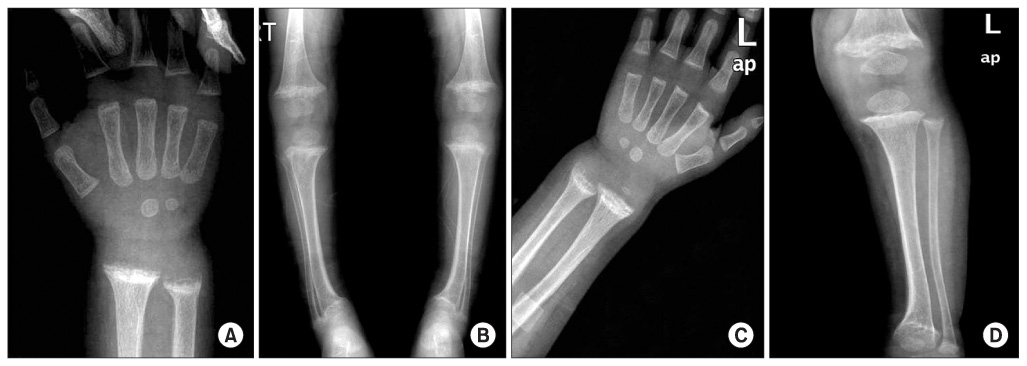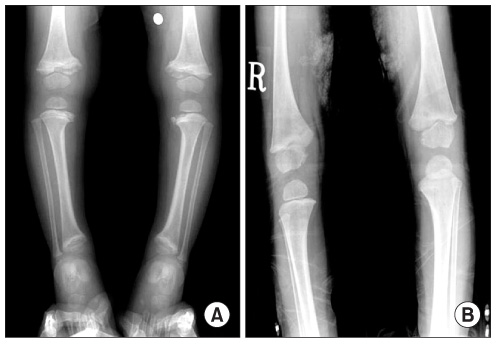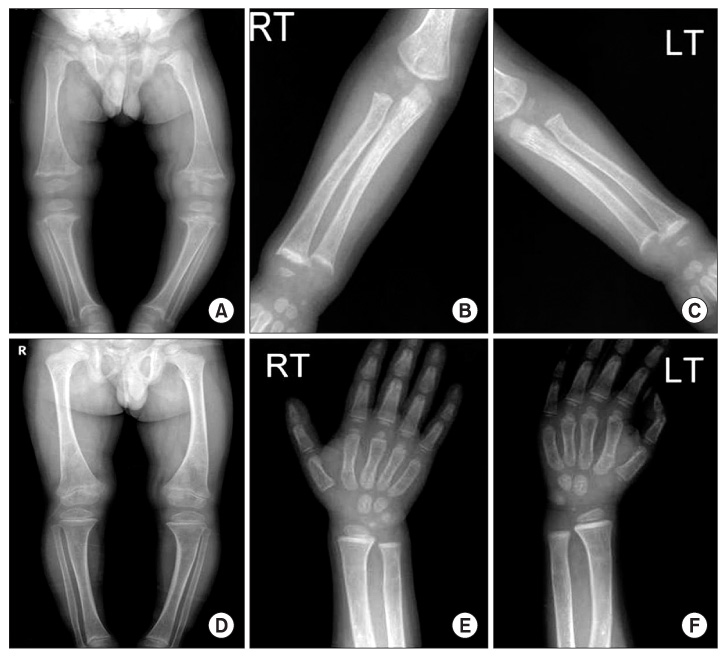J Korean Orthop Assoc.
2011 Oct;46(5):431-437.
Four Cases of Vitamin D Deficiency Rickets with Lower Extremity Deformities
- Affiliations
-
- 1Department of Orthopaedic Surgery, Chungnam National University College of Medicine, Daejeon, Korea. hyunsd@cnu.ac.kr
Abstract
- Since the overall nutritional status of the general population has improved nowadays and manufactured formulas contain vitamin D, the prevalence of vitamin D deficiency rickets has significantly decreased. Recently, however, 4 cases with lower extremity deformities came to the outpatient department. Among them, 1 case consumed only Sunsik (a powder mixture of several grains and fruits) instead of the manufactured formula, to control atopic dermatitis, 2 cases stopped eating due to diarrhea from milk feeds, and to control atopic dermatitis. 1 case was on a normal diet without any specific allergic reaction to foods, but had very less exposure to sunlight. Providing sufficient vitamin D and calcium, along with increasing the time of sunlight exposure have significantly improved the hematologic and radiologic findings, and the bone growth. The authors will explain the necessity of adequate supplementation of vitamin D and calcium, especially in cases which control or restrict their diet due to food allergies.
Keyword
MeSH Terms
-
Bone Development
Calcium
Edible Grain
Congenital Abnormalities
Dermatitis, Atopic
Diarrhea
Diet
Eating
Food Hypersensitivity
Growth Plate
Humans
Hypersensitivity
Lower Extremity
Milk
Nutritional Status
Outpatients
Porphyrins
Prevalence
Rickets
Sunlight
Vitamin D
Vitamin D Deficiency
Vitamins
Calcium
Porphyrins
Vitamin D
Vitamins
Figure
Reference
-
1. Behrman RE, Kliegman RM, Jensen HB, et al. Nelson textbook of pediatrics. 2007. 18th ed. Philadelphia: Saunders;253–262.2. Yang JA, Jang KA, Park HW, et al. A case of rickets developed after feeding on sunsik for seven months. J Korean Pediatr Soc. 2003. 46:1143–1146.3. Weaver CM, Fleet JC. Vitamin D requirements: current and future. Am J Clin Nutr. 2004. 80:6 Suppl. 1735S–1739S.
Article4. Gartner LM, Greer FR. Section on Breastfeeding and Committee on Nutrition. American Academy of Pediatrics. Prevention of rickets and vitamin D deficiency: new guidelines for vitamin D intake. Pediatrics. 2003. 111:908–901.
Article5. Institute of Medicine, Food and Nutrition Board, Standing Committee on the Scientific Evaluation of Dietary Reference Intakes. Vitamin D. Dietary Reference Intakes for Calcium, Phosphorus, Magnesium, Vitamin D, and Fluoride. 1997. Washington, DC: National Academy Press;250–287.6. Robert MK, Richard EB, Hal BJ, Bonita FS. Nelson textbook of pediatrics. 2007. 18th ed. Philadelphia: Saunders;257–259.7. Legius E, Proesmans W, Eggermont E, Vandamme-Lobaerts R, Bouillon R, Smet M. Rickets due to dietary calcium deficiency. Eur J Pediatr. 1989. 148:784–785.
Article8. Mullan MMC, Hunter JO. Brostoff J, Challacombe SJ, editors. Diagnosis of gastrointestinal food allergy and intolerance in adults. Food allergy and intolerance. 2002. 2nd ed. Philadelphia: Saunders;872.9. Cho YB, Yoon YS, Chang JY, Kim SM, Kim KS, Choi CH. Analysis and evaluation of the reliability of medical information on food allergies on the internet. Korean J Pediatr. 2004. 47:868–872.





